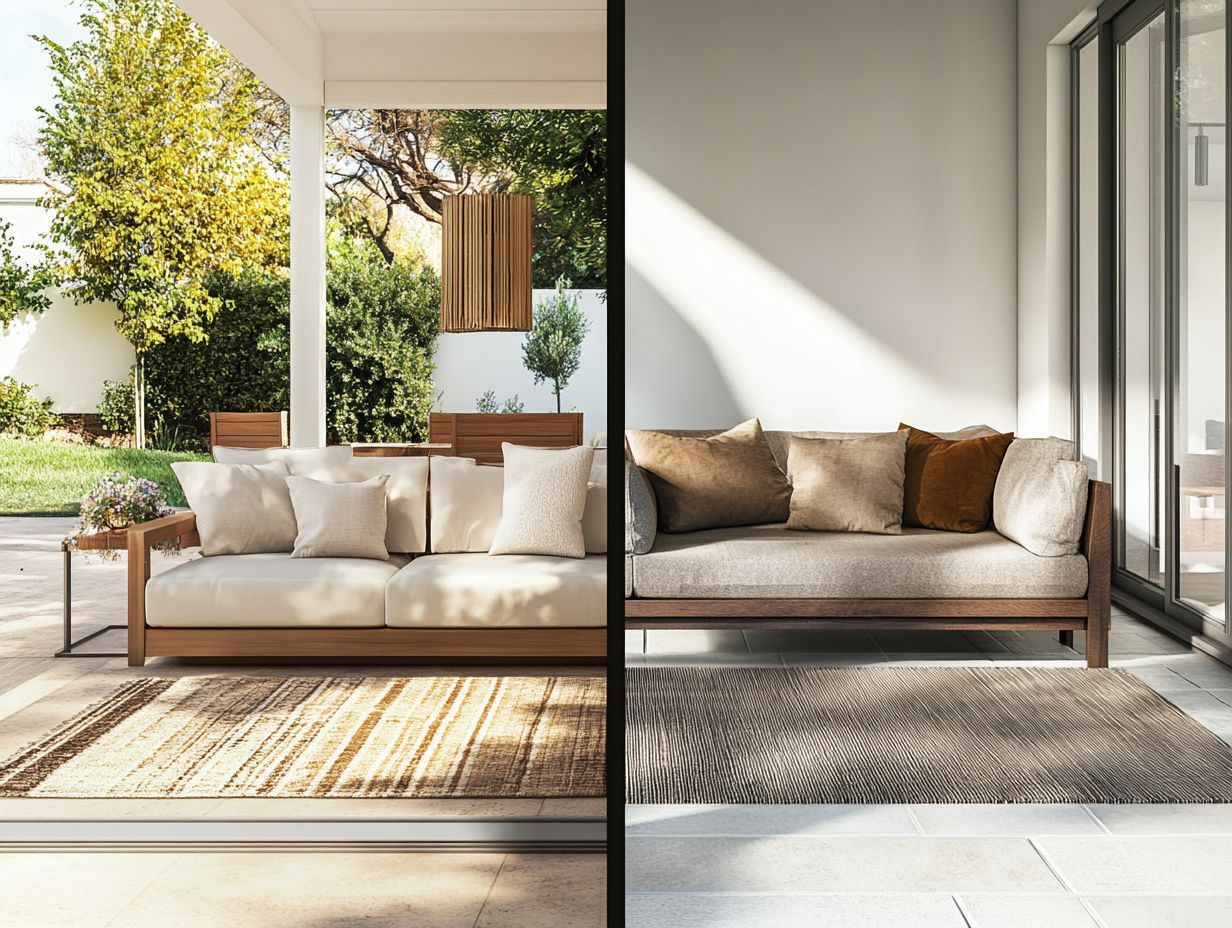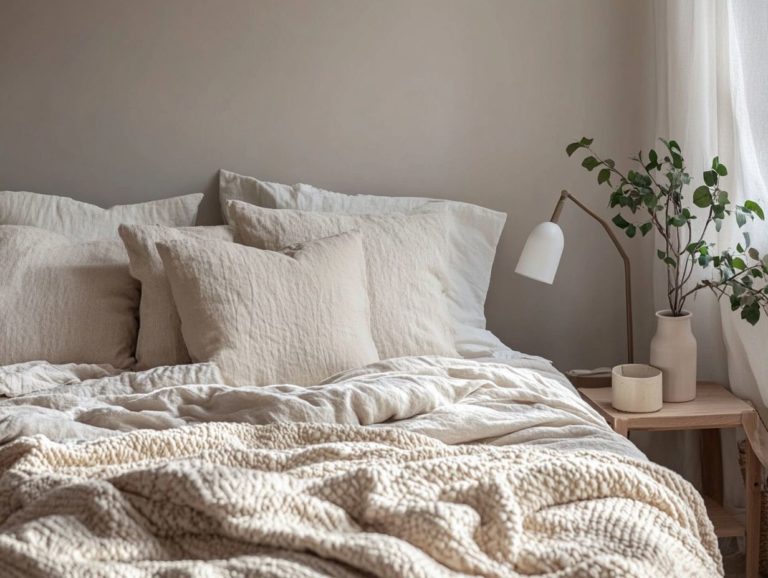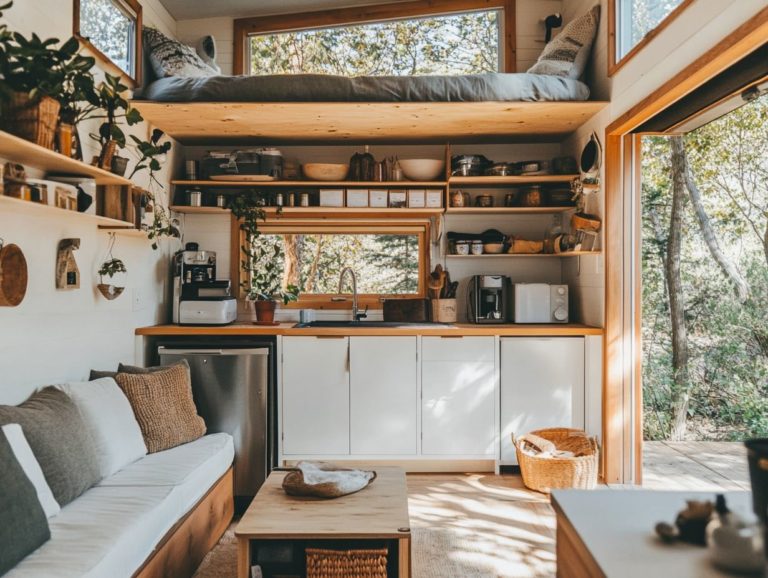What is the Difference Between Indoor and Outdoor Furniture?
When furnishing your home and outdoor areas, understanding the differences between indoor and outdoor furniture is essential. This includes various types such as wood furniture and aluminum furniture, each made for specific purposes and influenced by materials, durability, and design.
This article delves into how these two categories diverge in style, upkeep, and cost. It also highlights key elements to consider when making your furniture selection.
Whether enhancing your living room or designing a charming outdoor space, knowing these key differences can transform your space!
Contents
- Key Takeaways:
- Overview of Indoor and Outdoor Furniture
- Materials Used in Indoor and Outdoor Furniture
- Design and Style Differences
- Cost Comparison
- Factors to Consider When Choosing Between Indoor and Outdoor Furniture
- Frequently Asked Questions
- Can I use outdoor furniture in a covered outdoor space?
- What factors should I consider when choosing between indoor and outdoor furniture?
Key Takeaways:

- Indoor and outdoor furniture differ in materials, design, and cost.
- Indoor furniture is typically made with delicate materials like high-quality wood, while outdoor furniture is designed for durability and weather resistance using options such as teak wood.
- When choosing between indoor and outdoor furniture, consider factors like location, usage, and budget to find the best option for your needs.
Overview of Indoor and Outdoor Furniture
Indoor and outdoor furniture greatly influences your living spaces. Each offers unique benefits tailored to your needs. Recognizing the essential features of both categories is crucial whether you aim to elevate the charm of your interiors or create a cozy outdoor retreat.
Indoor furniture emphasizes comfort and design, showcasing upholstered chairs and finely crafted wood options. Outdoor furniture, in contrast, focuses on durability and functionality, utilizing weather-resistant materials like teak wood and synthetic wicker.
This overview explores the key distinctions between indoor and outdoor furniture, highlighting their suitability based on various factors.
Defining and Differentiating the Two
Defining indoor and outdoor furniture requires grasping their distinct purposes and the design factors that shape their functionality.
Indoor furniture is made from materials like wood, metal, and upholstered fabrics. It creates a cozy atmosphere that enhances various living spaces. This type places a premium on comfort and aesthetics, often showcasing intricate designs that complement your interior d cor.
Outdoor furniture is designed to withstand weather conditions. It is typically made from robust materials like teak and synthetic wicker. Its design prioritizes practicality and durability, featuring elements like UV-resistant coatings and moisture-repellent fabrics. This ensures it remains both functional and visually striking even in adverse weather.
Materials Used in Indoor and Outdoor Furniture
The choice of materials for both indoor and outdoor furniture ranging from eco-friendly materials to synthetic options is vital for achieving durability, functionality, and aesthetic beauty. This selection impacts the overall appearance and longevity of your pieces.
For indoor furniture, you often find high-quality wood and plush upholstery designed for comfort. In contrast, outdoor furniture typically features weather-resistant options like teak wood, aluminum furniture, and synthetic wicker, all engineered to endure varying weather conditions.
By understanding the properties of these materials, you can enhance your furniture maintenance and care routines, ensuring they remain beautiful and functional for years to come.
Explore various furniture options today to elevate your space!
Comparing Durability and Maintenance

When you re weighing the pros and cons of indoor versus outdoor furniture, furniture durability and maintenance and care are key considerations. Understanding the unique environmental challenges each one faces is essential.
Outdoors, your furniture endures relentless weather conditions, from the blazing sun that can cause fading to moisture that invites rot or rust. Opting for materials like teak, aluminum, or synthetic resin can assure you of longevity. However, it s crucial to understand their specific cleaning techniques and maintenance requirements.
For example, teak may need regular oiling to keep its rich luster, while aluminum could benefit from the occasional wash to fend off dirt buildup. Indoors, wood and upholstered pieces, like upholstered chairs, demand their own kind of care. Polishing and dusting are essential to ensure they always look their best.
Implementing protective finishes can significantly enhance the lifespan of your furniture. Regular cleaning and proper treatments protect your investment and create a beautiful, functional space that stands the test of time.
Design and Style Differences
The design and style distinctions between indoor and outdoor furniture are profoundly shaped by their intended purposes. When considering comfort, aesthetic appeal, and functional requirements, each category has its own priorities.
Indoor furniture typically emphasizes comfortable design and premium finishes that enhance the overall visual appeal of your home. In contrast, outdoor furniture is crafted to endure the elements while maintaining a stylish look.
Let s explore the exciting design features that make indoor and outdoor furniture unique, highlighting the intricate balance between functionality and artistry.
Factors Influencing Design Choices
Several factors influence your design choices when it comes to indoor and outdoor furniture, including functionality and material suitability. Insights from furniture experts can also guide you.
Prioritizing comfort is essential, as these elements ensure your indoor chairs and patio chairs meet your needs. Furniture experts often highlight the importance of ergonomics. This means designing furniture that helps you sit comfortably and supports your body well.
Aesthetic preferences will undoubtedly guide your decisions, shaping color palettes and selecting shapes that resonate with your unique taste. By blending durable yet stylish materials, designers curate cohesive looks that enhance any space.
Choose pieces that not only fit your lifestyle but also make your space shine, whether it s a cozy living room or an inviting patio.
Cost Comparison
When you compare the costs of indoor and outdoor furniture, you’ll often notice significant differences. These variations arise from several factors, including the quality of materials, the complexity of the design, and the intended use.
For example, commercial furniture typically commands a different price point than residential options.
Factors Affecting Price Differences

Price differences between indoor and outdoor furniture arise from a variety of factors, including material costs, durability, maintenance needs, and details in design, such as those found in commercial furniture.
When choosing materials, consider that outdoor pieces often require weather-resistant options like treated woods or synthetic fibers, made from man-made materials, that offer durability in outdoor settings. This can elevate their price due to their natural resistant properties.
Durability is another essential aspect; outdoor furniture must endure the elements, impacting its cost. Maintenance requirements also vary considerably. Indoor furniture typically demands simpler care, while outdoor options often need protective finishes to keep them looking their best.
Overall design details, like craftsmanship and comfort features, also affect the price. Make sure to consider your budget and quality expectations so your purchases are not only satisfying but also a wise investment.
Factors to Consider When Choosing Between Indoor and Outdoor Furniture
When you re deciding between indoor and outdoor furniture, there are several critical factors to weigh. Consider your location, intended usage like outdoor living, and budget constraints.
These elements will guide you in selecting both types, ensuring that your choices fit your space and enhance your lifestyle.
Location, Usage, and Budget
When choosing between indoor and outdoor furniture, location, usage, and budget are key factors that shape your final decision.
The environment, whether it be an indoor environment or an outdoor space, matters greatly. If you re in a humid coastal area, you ll want materials like teak or polyethylene that can withstand moisture. In a dry climate, metal or treated wood might be your best bet.
Usage patterns also play a significant role in your choices. If you have kids, you ll likely prefer durable, easy-to-clean surfaces, like those found in furniture used in restaurants. If aesthetics is your main concern, you might lean towards more elegant designs, even if they require extra maintenance.
Finally, budget considerations will refine your options. You ll want to find value that doesn t compromise style or comfort, allowing you to strike a balance between functionality and visual appeal.
Consider exploring upholstery cleaning tips to maintain your indoor pieces and ensure their longevity.
Frequently Asked Questions
What is the Difference Between Indoor and Outdoor Furniture?

Indoor furniture and commercial furniture are designed for use inside a home or building, while outdoor furniture and patio chairs are meant for open spaces.
Can I use indoor furniture outside and vice versa?
It is not recommended to use indoor furniture outside as it is not designed to withstand harsh weather conditions. While outdoor furniture can be used indoors, it may not be as aesthetically pleasing.
What materials are used to make indoor and outdoor furniture?
Indoor furniture is often made with materials like wood, fabric, and high-quality finishes, while outdoor furniture typically uses weather-resistant materials like synthetic wicker, aluminum, and teak wood.
Is there a difference in maintenance between indoor and outdoor furniture?
Yes, indoor furniture may require more frequent cleaning and upkeep. Outdoor furniture needs protection and storage during harsh weather to ensure durability.
Explore our collections today to find the perfect match for your home!
Can I use outdoor furniture in a covered outdoor space?
Yes, you can use outdoor furniture in covered spaces. However, keep in mind that it might still face some weather and will need more upkeep than furniture in a fully sheltered area.
What factors should I consider when choosing between indoor and outdoor furniture?
Think about how you ll use the furniture and where you ll place it. Consider the climate, materials, comfort, and how it looks.






